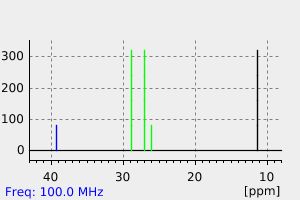Cyclohexyldimethylphosphin | 58359-87-8
中文名称
——
中文别名
——
英文名称
Cyclohexyldimethylphosphin
英文别名
InChI=1/C8H17P/c1-9(2)8-6-4-3-5-7-8/h8H,3-7H2,1-2H;cyclohexyl(dimethyl)phosphane
CAS
58359-87-8
化学式
C8H17P
mdl
——
分子量
144.197
InChiKey
UIXNOFOTEDKIIH-UHFFFAOYSA-N
BEILSTEIN
——
EINECS
——
-
物化性质
-
计算性质
-
ADMET
-
安全信息
-
SDS
-
制备方法与用途
-
上下游信息
-
文献信息
-
表征谱图
-
同类化合物
-
相关功能分类
-
相关结构分类
计算性质
-
辛醇/水分配系数(LogP):1.7
-
重原子数:9
-
可旋转键数:1
-
环数:1.0
-
sp3杂化的碳原子比例:1.0
-
拓扑面积:0
-
氢给体数:0
-
氢受体数:0
反应信息
-
作为产物:描述:二甲基苯基磷 在 Nb(OC6H3Ph2-2,6)2(CH2C6H4-4Me)3 、 氢气 作用下, 以 环己烷 为溶剂, 80.0 ℃ 、8.27 MPa 条件下, 反应 24.0h, 生成 Cyclohexyldimethylphosphin参考文献:名称:Catalytic hydrogenation of aryl phosphines by niobium aryloxide compounds: high yield and efficient synthesis of cyclohexyl phosphine ligands摘要:三(4-甲基苄基)化合物Nb(OC6H3Ph2-2,6)2(CH2H4-4Me)31(OC6H3Ph2-2,6 = 2,6-二苯基苯氧)作为催化剂前体用于各种芳基膦配体的氢化。DOI:10.1039/c39920000632
文献信息
-
ANTIMICROBIAL CATIONIC POLYCARBONATES申请人:INTERNATIONAL BUSINESS MACHINES CORPORATION公开号:US20140301967A1公开(公告)日:2014-10-09Antimicrobial cationic polymers having one or two cationic polycarbonate chains were prepared by organocatalyzed ring opening polymerization. One antimicrobial cationic polymer has a polymer chain consisting essentially of cationic carbonate repeat units linked to one or two end groups. The end groups can comprise a covalently bound form of biologically active compound such as cholesterol. Other antimicrobial cationic polymers have a random copolycarbonate chain comprising a minor mole fraction of hydrophobic repeat units bearing a covalently bound form of a vitamin E and/or vitamin D2. The cationic polymers exhibit high activity and selectivity against Gram-negative and Gram-positive microbes and fungi.
-
PROCESS FOR PRODUCING PHENYL-SUBSTITUTED HETEROCYCLIC DERIVATIVE THROUGH COUPLING USING TRANSITION METAL CATALYST申请人:Komiyama Masato公开号:US20110313169A1公开(公告)日:2011-12-22A process for efficiently producing, through few steps either a xanthine oxidase inhibitor, which is a therapeutic agent for hyperuricemia, or an intermediate therefore. The process is a novel coupling process which comprises subjecting a compound represented by formula (1) to coupling reaction with a compound represented by formula (2) in the presence of a transition metal compound to thereby obtain a compound represented by formula (3).
-
Method for preparing aminoarylborane compounds or derivatives thereof申请人:Université de Bordeaux I公开号:EP2881398A1公开(公告)日:2015-06-10The present invention provides a process for the preparation of aminoarylborane compounds and derivatives thereof comprising a step of arylation by reacting an aryl chloride with an aminoborane compound in the presence of a catalytic system. Typically, the transformation comprises, converting Aryl-chloride Ar-Cl with an aminoborane such as into an aminoarylborane compound of the following formula:
-
METHOD FOR PRODUCING CATALYST FOR CYCLIC CARBONATE SYNTHESIS申请人:MARUZEN PETROCHEMICAL CO., LTD.公开号:US20160108071A1公开(公告)日:2016-04-21The present invention provides a method for easily and inexpensively producing a heterogeneous catalyst used to synthesize a cyclic carbonate by reacting an epoxide with carbon dioxide and having excellent catalyst activity; a catalyst obtained using said manufacturing method; and a method for synthesizing a cyclic carbonate using said catalyst. A method for producing a catalyst that is used for the purpose of synthesizing a cyclic carbonate by subjecting to a reaction an epoxide with carbon dioxide, said method comprising the following steps (a) and (b): (a) a step of obtaining a catalyst precursor having a haloalkyl group or a haloaryl group by reacting a silane compound with a silica gel in the presence of xylene, the silane compound having a haloalkyl group or a haloaryl group and (b) a step of obtaining a catalyst for synthesizing a cyclic carbonate by reacting the catalyst precursor obtained in step (a) with a tertiary phosphine.
-
VITAMIN FUNCTIONALIZED GEL-FORMING BLOCK COPOLYMERS FOR BIOMEDICAL APPLICATIONS申请人:INTERNATIONAL BUSINESS MACHINES CORPORATION公开号:US20180117162A1公开(公告)日:2018-05-03Gel-forming block copolymers were prepared comprising i) a central hydrophilic block consisting essentially of a divalent poly(ethylene oxide) chain and ii) two peripheral monocarbonate or polycarbonate hydrophobic blocks linked to the central block by linking groups bearing one or more hydrogen bond forming *—N(H)—* groups. The hydrophobic blocks comprise one or more vitamin-bearing subunits. The gel-forming block copolymers can be used to prepare various biodegradable and/or biocompatible hydrogel and organogel drug compositions, in particular antimicrobial and/or anti-tumor drug compositions. The hydrogel compositions have utility in depot injections for drug delivery. The hydrogen bonding *—N(H)—* group(s) provide longer in vivo lifetime of the hydrogel before degradation and a more prolonged and controlled release rate of a hydrophobic drug compared to similar hydrogels prepared from poly(ethylene glycol).
表征谱图
-
氢谱1HNMR
-
质谱MS
-
碳谱13CNMR
-
红外IR
-
拉曼Raman
-
峰位数据
-
峰位匹配
-
表征信息
同类化合物
顺-二氯双(三乙基膦)铂(II)
镍,二氯二[三(2-甲基丙基)膦]-
铂(三乙基膦)4
辛基二丁基氧膦
辛基[二(2,4,4-三甲代戊基)]磷烷氧化
膦,(1-甲基-1,2-乙二基)二[二(1-甲基乙基)-
羰基氯氢[双(2-二-异丙基膦酰基乙基)胺]钌(II)
羰基氯氢[二(2-二环己基膦基乙基)胺]钌(II)
羰基氯氢[二(2-二叔丁基膦乙基)胺]钌(II)
硅烷,三环己基-
癸基二辛基氧化膦
甲基双(羟甲基)膦
甲基二辛基氧膦
甲基二乙基膦
甲基(二丙基)膦
环戊基二戊基氧膦
环己基双十八烷基膦
环己基双十二烷基膦
环己基二辛基膦
环己基二异丁基氧膦
环己基二己基膦氧化物
环己基二己基膦
环己基二叔丁基膦
烯丙基乙烯基膦酸
氯甲基(二甲基)氧膦
氯化二氢[双(2-di-i-丙基膦酰乙基)胺]铱(III)
氯化(双三环己基膦)(一氧化碳)(氢)钌
氯代三叔丁基磷化金(I)
氯(三甲基膦)金
氯(三乙基膦)金(I)
氨合二氯(1-(二甲基亚膦酰)甲胺-N)铂
氧化膦,亚甲基二[二甲基-
氧化膦,二丁基乙基-
氧化膦,二(碘甲基)甲基-
氧化膦,三十六烷基-
氧化膦,三(癸基)-
正丁基二(1-金刚烷基)膦
替曲膦
叔丁基双(2,2-二甲基丙基)膦
叔丁基二环己基膦
叔丁基二异丙基膦
叔丁基二乙基膦
叔丁基(二甲基)膦
双异丁基丁基磷烷
双[2-(二环己基)乙基]胺
双[2-(二-叔丁基膦基)乙基]胺
双[2-(二异丙基膦基)乙基]胺
双[2-(二叔丁基膦)乙胺]二氯化钌
双[1,3-双(二异丙基膦)丙烷]钯
双(羟甲基)甲基膦氧化物







